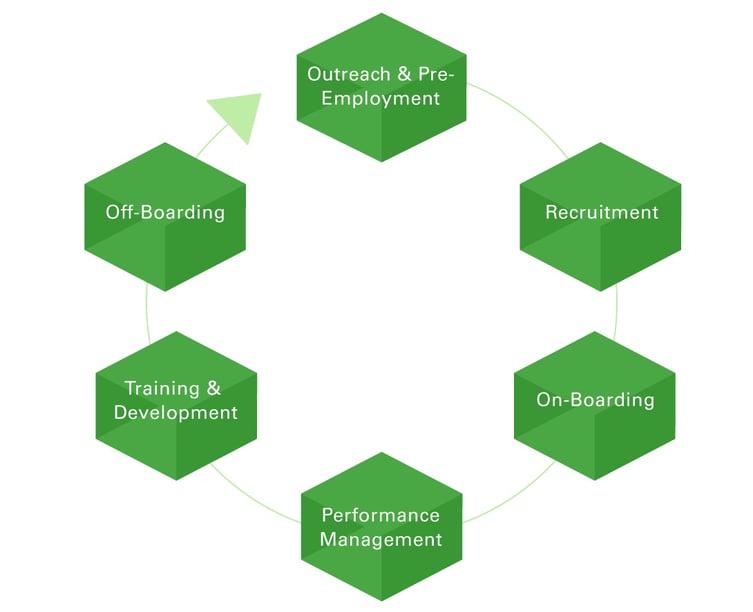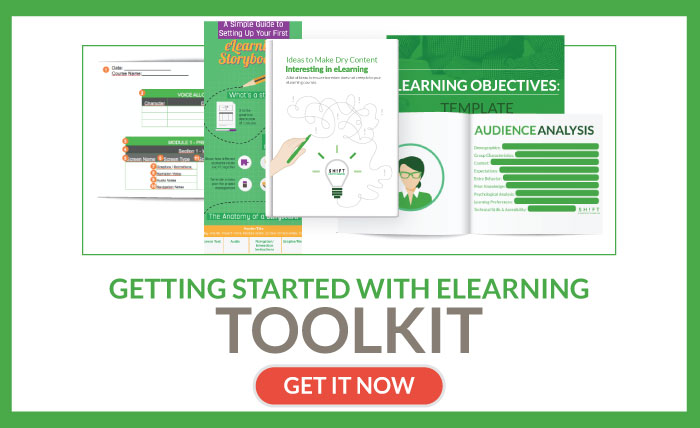Every job position should be viewed in its entirety, from the hiring process to retirement (or resignation/firing). Organizations must provide the circumstances and resources necessary to develop the knowledge, skills, and abilities of their employees every step of the way. This point of view helps organizations set their employees up for success, and has the added benefit of improving employee retention and engagement.
The Employee LifeCycle
The employee lifecycle is an ongoing process that starts and ends with competent employees in your organization. Training, in one form or another, is essential for every aspect of this lifecycle. Unfortunately, too many organizations view training as isolated events or particular sets of educational materials that are designed with a specific learning goal in mind.
To be most effective, however, your L&D programs need to be re-conceptualized as a continuous process of exploration, discovery, and development, that leads to learning throughout the entire employee lifecycle. Let’s take a look at each stage of this lifecycle, and how training and development can contribute to the success of each one.

Stage 1: Outreach & Pre-Employment
In the outreach and pre-employment stage, training and development can take the following forms:
- Helping candidates understand the 3 R’s of employment: roles, responsibilities, and risks. This can be accomplished through realistic job previews and online simulations of on-the-job experiences.
- Offering internships and pre-employment training.
- Posting job descriptions, along with the company’s mission, vision, and core values on the company’s external website.
Pre-employment orientation and training can be effectively delivered through eLearning, which does not require candidates to physically visit the organization’s facilities. Another key to effective outreach and pre-employment is to involve organizational experts and other stakeholders, who can use their knowledge and expertise to guide the development process.
Stage 2: Recruitment
Once suitable candidates have been located that align with an organization’s vision, mission, and culture, a more specific recruitment process needs to take place. This is all part of your talent management effort, which involves:
- Developing behavior and competency-based interview questions.
- Preparing up-to-date and detailed job descriptions that capture relevant competencies and skills required for specific jobs and/or organizational practices
Effective recruitment will set up potential employees for quick assimilation into their new roles since they will know exactly what to expect.
Stage 3: On-Boarding
On-boarding is far more than merely conducting an employee orientation. It is an entire process by which new employees acquire the skills, knowledge, and behaviors that will permit them to become effective contributors within an organization.
For successful on-boarding of employees, you will need:
- A formal onboarding framework
- Procedures in place that will ensure regular evaluation of onboarding effectiveness
- Oversight of the process, to ensure consistency of your onboarding and training programs
A recent study concluded that employees are 69% more likely to stay with a company for at least three years if they experience great on-boarding. It should start immediately, and provide new hires with multiple sources of information, as well as two-way communication with management.
Read more: What an Effective Onboarding eLearning Course Should Look Like
Stage 4: Performance Management
Employees will continue to learn, develop, and grow throughout their tenure with your organization. So naturally, it’s important to provide them will tools and resources to support them. These include, but are not limited to:
- Performance goals, evaluations, and assessments
- High potential and high performer programs
- Rotational assignments
- Special projects
- Leadership eLearning development programs
- Mentoring programs
- Networking
- Career-pathing
- Succession planning
- Recognition and awards
These activities all support your learning development program and will enhance retention. It is through these activities that companies can begin identifying where they are at risk for the loss of information and experience by identifying employees who possess the most critical knowledge.
Stage 5: Training & Development
Traditional training and development programs will always be an essential component of the employee lifecycle. Developing new skills and abilities, as well as updating existing knowledge will be continuously required just to keep pace with new developments in technology as well as new processes and procedures.
One exciting new development in the area of training and development is the advent of eLearning. This delivery method has freed organizations from the inaccurate belief that learning can only occur in classroom settings when it’s officially administered by Human Resources.
Some of the benefits of eLearning include:
- Consistent distribution of high-quality content
- Anytime, anywhere learning
- Learner-driven and just-in-time lessons
- Simulations, where completing tasks look like the real thing
- Immediate insights, assessments, and feedback
- Resource materials that are available at the point of trial and error
Also read: 7 Types of Training Programs That Should Now Be Converted to eLearning
Stage 6: Offboarding
Off-boarding typically consists of exit interviews and evaluations. But before seasoned and experienced employees leave, it is important to put in place mechanisms where they can share or distribute their knowledge, skills, and behaviors with the employees who replace them. This process ultimately mitigates organizational knowledge loss and completes the employee lifecycle, with exiting employees contributing to the development of new employees.
With more and more baby boomers retiring and taking their expertise with them, it is important to systematically capture their knowledge and make it available to new hires. This process should become routine and easy because, without a systematic process to document changes and updates to job tasks, procedures, and processes, there will be no knowledge to transfer.
Continuous Organizational Knowledge
Acquiring and maintaining organizational knowledge is not something that has a beginning and an ending. It is a continuous process. That is why Learning and Development professionals must develop knowledge management strategies and tactics for each aspect of the employee lifecycle.
Also read: Learning Is Not a One-Time Event! Promote Continuous Learning
REFERENCES:
Why Understanding the Employee Lifecycle is Essential for Business Growth
Six Stages to Success with the Employee Lifecycle
Managing Knowledge Across the Employee Lifecycle: Training in the New Millennium



